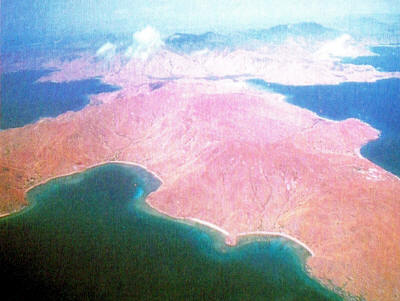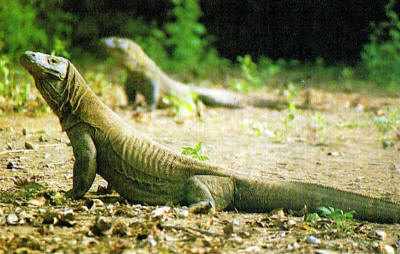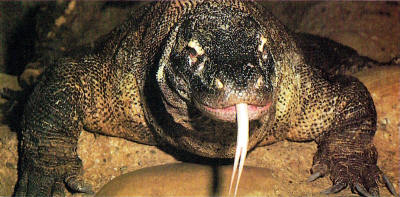|
Komodo Dragon

At 10 feet in
length, the Komodo dragon is the largest
true lizard that has ever lived
on land.
It is the top
predator on the small islands on which it lives.
Armed with the sharp claws
and powerful tail of its mythical namesake,
the Komodo dragon
may not actually breathe fire but, when it is aroused,
it will hiss and
flick its forked tongue menacingly.
The dragon's thick,
scaly skin is greenish brown and marked all over with
red circles.
|
|

BEHAVIOR
Komodo dragons, like most cold-blooded reptiles, sleep during the night.
As the sun rises and warms their blood, they become active, awaking from
their resting places among tree roots and rocks and set out in search of
food.
Despite their great size, Komodo
dragons are quick-moving and agile on the ground. They occasionally
climb trees, gripping them with their large, powerful claws. They
are also good swimmers, taking long, powerful strokes with their tails.
When the usually solitary Komodo
dragons meet, they establish a clear pecking order based on size.

After mating,
the female lays oval, white eggs
in a hole excavated in the earth.
FOOD & HUNTING
Komodo dragons will eat anything
they can catch and overpower, including other Komodo dragons.
Favorite prey include wild pigs, deer and monkeys.
Though Komodos can move quickly, they can
do so only over short distances. So, they hunt by ambush, waiting
for prey to wander into range, then seizing it in their jaws.
Younger Komodos are more mobile than adults, and
they will actively hunt small mammals, nestling birds and insects.
Once prey is caught, the Komodo holds it in its claws and rips off
chunks of flesh with its teeth.
Komodos also eat carrion.

When Komodos
meet at a kill, a clear
pecking order exists,
with the larger
Komodos getting the best pickings.
|
HABITAT
The small Indonesian islands on which the Komodo dragon lives are hilly
and sparsely covered with rainforest. The lowland areas consist
mainly of open grassland and palm trees. Despite their small size,
these islands support a wide range of subtropical plants and animals.

BREEDING
Komodo dragons mate
in late June or July. During this period, males may come into conflict with each other as they defend their territories.
Five weeks after mating, the female digs
a hole in the warm, moist earth and lays an average of a dozen eggs.
The exact number and size of the eggs she lays vary, depending on the age
and size of the female. She then covers them and leaves them to
incubate unattended, relying on the sun to keep them at the proper
temperature.
The young dragons hatch eight months
later. Barely eight inches long, they are in danger of being eaten by
almost every predator on the islands, from snakes and birds of prey to
larger Komodo dragons. Those that survive grow quickly and, after
five years, they will have reached six feet in length. Both males
and females are mature enough to breed at around six years of age.

The Komodo
uses its tongue to "taste" the air.
DID YOU KNOW?
● The
Komodo dragon was only discovered in 1912.
●
An adult Komodo will eat an entire deer at one time − and then sleep
for a week while digesting it.
●
Young Komodo dragons hatch from their leathery, goose-sized eggs fully
formed.
●
Unlike other large monitor lizards which have long, whip-like tails, the
tail of the heavy-bodied Komodo dragon only accounts for half its length.
|


![]()
![]()